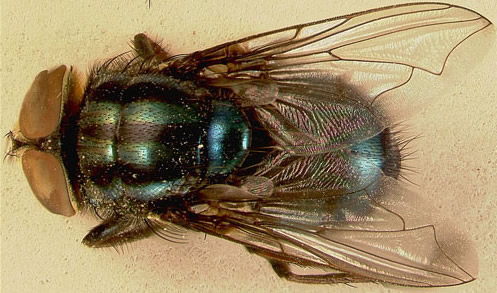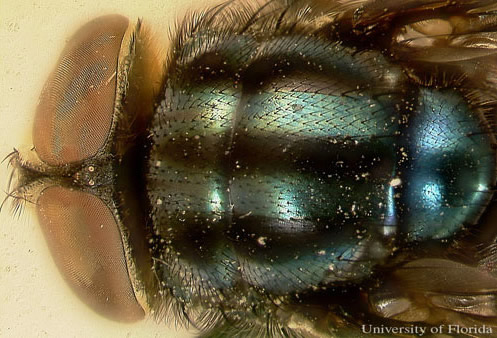common name: secondary screwworm
scientific name: Cochliomyia macellaria (Fabricius) (Insecta: Diptera: Calliphoridae)
Introduction - Distribution - Description - Life Cycle - Medical and Economic Importance - Forensic Importance - Management - Selected References
Introduction (Back to Top)
Insects in the family Calliphoridae are generally referred to as blow flies or bottle flies. Blow flies can be found in almost every terrestrial habitat. Most species are of considerable economic importance to both humans and livestock. Due to its distribution and abundance, the secondary screwworm, Cochliomyia macellaria, is of particular importance in the United States.
Figure 1. Adult secondary screwworm, Cochliomyia macellaria (Fabricius). Photograph by Matt Aubuchon, University of Florida.
Distribution (Back to Top)
The secondary screwworm ranges throughout the United States and the American tropics. It also is found in parts of southern Canada during the summer months. It is especially common in the southeastern United States where it is present throughout the year.
Description (Back to Top)
Adults are variable in size with most ranging from 5 to 8 mm in length. The body is metallic greenish-blue and characterized by three dark green longitudinal stripes on the dorsal thorax. The eyes are large, covering most of the head, and appear orange-red.
Figure 2. Head and thorax of adult secondary screwworm, Cochliomyia macellaria (Fabricius). Notice the three dark green longitudinal stripes on the dorsal thorax. Photograph by Matt Aubuchon, University of Florida.
Larvae, called maggots, are cream colored and legless. They feed on carrion. A mature maggot can reach lengths up to 17 mm.
The puparium is the hardened and shrunken outer skin of the mature maggot. The pupa develops entirely within this hardened shell, which looks similar to a rat dropping or a cockroach egg case.
Life Cycle (Back to Top)
The fly life cycle includes four life stages: egg, larva, pupa, and adult. The eggs are approximately 1 mm long and are laid in a loose mass of 50 to 200 eggs. Group oviposition by several females results in masses of thousands of eggs, which may completely cover a decomposing carcass. The eggs hatch in about 24 hours (depending on air temperature) and the larvae feed on the carrion until they reach maturity. Larvae can reach the mature or post-feeding stage in as little as four days. Upon maturity, they migrate away from the carrion to search for a suitable pupation site. Pupation usually occurs within the first inch of topsoil or under leaf litter, rocks, or fallen limbs. During this time, the larval skin shrinks and hardens to form the puparium, which is dark brown. This stage may last from seven to ten days depending on temperature. The adults can live up to six weeks.
Medical and Economic Importance (Back to Top)
When fly larvae (maggots) infest the tissues of living animals or humans, the resulting condition is termed myiasis and is of great medical and veterinary importance. The livestock industry considers the secondary screwworm an important pest because of the enormous economic losses caused by cases of myiasis and disease transmission. Fortunately, this species does not feed on actual living tissue as does the primary screwworm. Secondary screwworms invade to feed on dead tissues after an injury has occurred. Thus they can be controlled through proper animal management and wound care. Although this species has been noted in conjunction with sheep strike, it is not considered of great economic importance within the sheep industry. Disease transmission linked to this species include limberneck (botulism in birds), 12 different Salmonella types including Salmonella typhimurium, poliomyelitis, and swine influenza. The secondary screwworm is considered to be very beneficial as a decomposer.
Forensic Importance (Back to Top)
Recently this species has gained recognition in the field of forensic entomology as a principal species on which to base postmortem interval estimations. This blow fly is a valuable forensic tool because its succession and occurrence on decomposing remains has been well defined. In the southeastern United States, the adults are attracted to carrion only minutes after death, but a 24-hour colonization delay may occur in other parts of the United States. This is one of the most common species of blow flies found on decomposing remains in the southern United States.
Management (Back to Top)
This species must have access to decomposing carcasses, carrion or rotten meat in order to complete its life cycle. Therefore, the proper removal of garbage and carcasses will disrupt the life cycle. The removal of vegetative refuse will reduce the annoyance of resident adult populations and risk of recontamination.
Insect Management Guide for filth-breeding flies
Livestock Pest Management
Selected References (Back to Top)
- Byrd JH. 1995. The effects of temperature on flies of forensic importance. M.S. thesis. University of Florida. 197 p.
- Byrd JH, Butler JF. 1996. Effects of temperature on Cochliomyia macellaria (Diptera: Calliphoridae) development. Journal of Medical Entomology 33: 901-905.
- Castner JL, Byrd JH, Butler JF. 1996. Forensic insect field identification cards. Forensic Sciences Foundation, American Academy of Forensic Sciences. Colorado Springs, CO.
- Hall DG. 1948. The blow flies of North America, Thomas Say Foundation Publication vol. 4. Entomological Society of America, Lanham, MD. Publishers.
- James MT. 1947. The flies that cause myiasis in man. U.S. Department of Agriculture Miscellaneous Publication 631.
- Laake EW, Cushing EC, Parish HE. 1936. Biology of the primary screwworm fly, Cochliomyia americana, and a comparison of its stages with those of C. macellaria. U.S. Department of Agriculture Technical Bulletin
- Smith KGV. 1986. A manual of forensic entomology. Cornell University Press. Ithaca, NY. 205 p.
- Wells JD, Greenberg B. 1992. Estimating maggot age from weight using inverse prediction. Journal of Forensic Science 40: 585-590.

